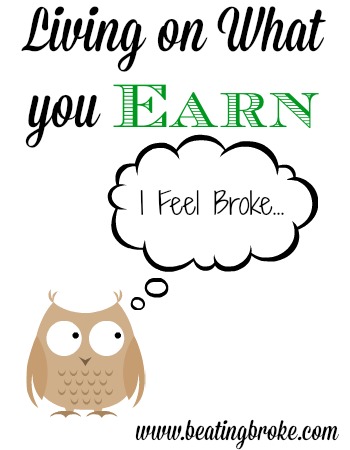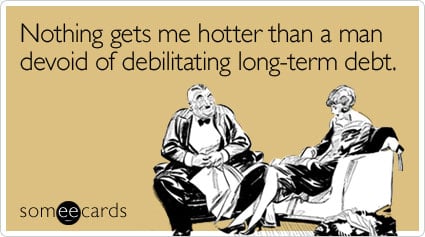Living on what you earn can be a difficult thing. For many, it seems like a little like a foreign language; difficult to learn to do, and backwards. But, if you can learn it, and transform your life into one where you’re living on what you earn, it can make a whole lot of difference. You’ve got to start somewhere, though. I, like you, haven’t always lived on what I earned.
Almost all of my life, I’ve owed someone something. When I was 19, I needed a car. My parents, tired of having me call them late at night after my old, beater car had broken down—AGAIN!—, decided I should buy a new car.
I didn’t qualify for a loan yet, so my grandpa lent me the money, and I paid him back with a small amount of interest, which was less than I’d pay borrowing from the bank and more than he’d make in a safe investment.
Soon after, I went away to college and took out student loans and started running a balance on my credit cards.
By the time I finally paid off my student loans a few years ago, my husband had his own loans that we had to pay.
Can you see me, just like the proverbial hamster running on the hamster wheel?
 I owe, I owe, it’s off to work I go.
I owe, I owe, it’s off to work I go.
Until one day, I said, “Enough!”
No more.
Time to live on what we make.
Time to stop borrowing.
Time to start saving.
And that’s when the real challenge began.
Our society is built on borrowing. Borrow for school, borrow for a car, borrow for a house, rent to own, pay in 10 easy installment plans.
I’m done living that lifestyle, but in turn, I’ve picked a much more challenging lifestyle—living on what we earn.
Cutting Until There’s No Room Left to Cut
The first thing I did was develop a frugal, written budget. That meant taming our grocery budget from $700 to $1,000 a month to $500 a month to feed our family of 5 with gluten, dairy and corn intolerances. It isn’t easy, but we’re doing it.
The next step was to keep a record of everything we spend. Honestly, I hate keeping this record, so that alone is incentive to spend less.
I spend an hour or so every week, reconciling the budget and making sure we’re on track.
I also started regularly saving for irregular expenses. Every other week, I put $120 in an account earmarked for utilities. In the winter, our utilities fall far below that, but I still keep saving the money for the expensive summer months. This way our utility costs are the same all year long.
Handling Unexpected Expenses
While the new budget can feel somewhat restrictive, what I find most difficult are the unexpected expenses. Just recently, I found that two of my kids have cavities (quite a few!), and the price for fixing them is around $400. I have money set aside in a medical fund, but filling the cavities will just about wipe that money out.
The problem is that we have many other medical expenses–$188 for my son to get new glasses and an eye exam and a pending $3,300 expense for him to get braces. I could put his braces on an interest free payment plan, but we don’t do payment plans anymore, interest free or not.
Instead, we had to make hard decisions like canceling our trip to see family this summer.
Living on cash is definitely not easy, but I know once we get through the next couple of years, as our income increases, it will get easier.
We are, as Dave Ramsey says, “Living like no one else so later we can LIVE like no one else.”
Do you eschew debts and payment plans, or do you use them in moderation to meet your goals?
Melissa is a writer and virtual assistant. She earned her Master’s from Southern Illinois University, and her Bachelor’s in English from the University of Michigan. When she’s not working, you can find her homeschooling her kids, reading a good book, or cooking. She resides in New York, where she loves the natural beauty of the area.



